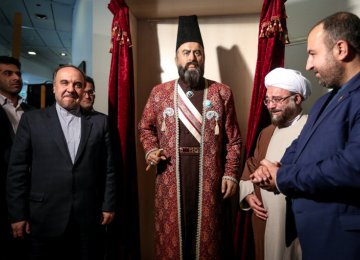The unveiling ceremony of the statue of Amir Kabir was held to commemorate his death anniversary at Tehran’s Milad Tower Hall of Fame Museum, on Sunday (Jan 11).
The silicone statue of the great political and cultural figure in the history of Iran, created by Alireza Khaghani was placed besides 13 other Iranian luminaries at the museum.
Milad Tower Manager Farzad Hoshyar called the tower a national monument which is host to the richest artistic and cultural events. “Today anyone who sees the tower from whichever part of the city is reminded of the finest programs hosted in the field of art and culture,” reports ISNA.
Dubbing Amir Kabir as the founder of modern thought in Iran as well as the world, Hoshyar added, “the contributions and great services this notable man made 150 years ago can still be seen in the country in the present times.”
He pointed to a number of graduates from Darolfonoon institution of higher education that were present at the ceremony and said: “Lots of scholars and artists finished their studies at this school.”
Head of Iran’s Cultural Heritage, Handicrafts and Tourism Organization (ICHHTO) Masud Soltanifar, Director of the National Library Seyed Reza Salehi-Amiri, Deputy Minister of Education Mohyedin-Bahram Mohamadian were also among the speakers at the ceremony who lauded the role of Amir Kabir in the history of Iran.
Influential
Other prominent statues at the museum are of contemporary poets Nima Yooshij and Sohrab Sepehri, author Jalal Ale-Ahmad, etc.
Mirza Taghi Khan Farahani known as Amir Kabir (1807-1852), was chief minister to Naser al-Din Shah Qajar (shah of Persia) for the first three years of his reign and one of the most capable and innovative figures of the Qajar period. He was put to death in the city of Kashan in 1852 on the order of the shah. Among the various measures enacted by Amir Kabir, the foundation of the Darolfonoon in Tehran was possibly the most influential.
The initial purpose of the institution was to train officers and civil servants to pursue the regeneration of the state that he had begun, but as the first educational institution giving instruction in modern learning, it had far wider impact. Amir Kabir made a second indirect contribution to the elaboration of Persian as a modern medium with his foundation of the newspaper Vaqaye-e Etefaqiyeh.





